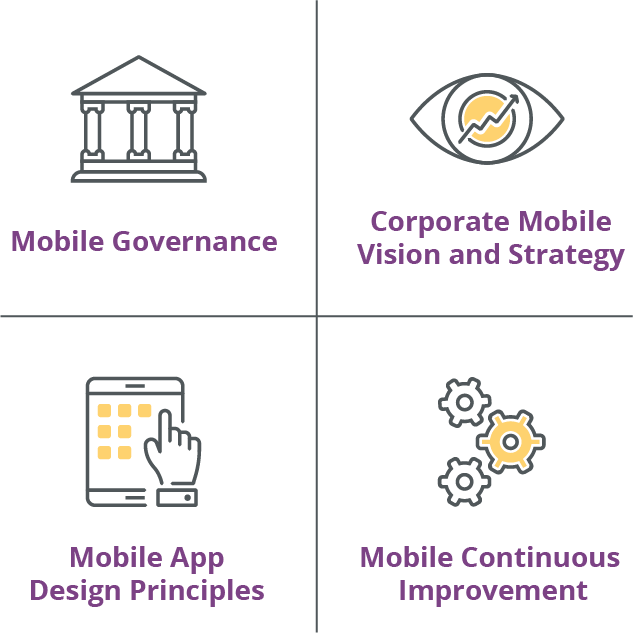06/09/2021
Digital transformation and mobility are revolutionizing almost every aspect of our personal lives – from how we travel, to how we get our entertainment, to managing our finances, to shopping – and the list goes on and on. No matter what the need is, we expect to instantaneously find what we are looking for on-the-go and at our fingertips with accessible and easy-to-use mobile applications, or apps.
This has never been truer than today, where we will soon have more cell phones than people on the planet. It is inevitable, then, that mobility has become an integral part of how we work. Many companies use mobile phones, rather than desk phones, as their primary communication device. The need for corporate mobile strategy and mobile apps in the work force is being driven by the need for:
- Allowing the always-connected customer access to your business activities
- Empowering your employees to be responsive to customer needs and experience
- Connecting your employees to backend systems and information needed to do their jobs
- Securing and protecting critical information about your employees and customers
Companies on the leading edge of executing a corporate mobile strategy should consider the key areas listed above. The prevalence of mobile phones in the workplace is the first step. However, at the heart of all mobility requirements in the workplace, is employee adoption of mobile apps. These mobile apps need to be effective and efficient tools for employees to get their jobs done more easily, and most importantly, to have a positive impact on your company’s ability to serve your customers, giving them the best possible experience. Ultimately, happy employees will lead to happy customers.
At the heart of all mobility requirements in the workplace, is employee adoption of mobile apps.
There are four key areas to focus on when deciding to launch an employee-facing mobile app:

We will focus on Mobile Governance and Corporate Mobile Vision and Strategy: the “what” of your corporate mobile strategy. We will review best practices in these areas and evaluate the importance of both for driving employee adoption of mobile apps. This will also provide insight into the connection between the mobile employee experience and how it impacts the customer experience.
Governance: Establish Holistic Mobile Framework
A key area when starting a corporate mobile app project is the management and governance of your mobile initiatives. Governance includes an overarching company-wide mobile governance framework, process, and set of roles and responsibilities that define how your mobile policies, decisions, and solutions will be created and managed. In this case, this framework should lay out how your mobile applications will be designed, created, managed, and controlled.
Mobile apps, by nature, impact many different parts of an organization, and they should, especially since it takes many departments and functions (marketing, sales, service, shipping, transportation, supply chain, etc.) to deliver for your customers. As such, all areas should feel a sense of ownership for mobile apps and how they are designed and used across the enterprise by the employees of the company. In the absence of an all-encompassing mobile governance framework and approach to manage unique requirements by department, your corporate mobile apps can become disjointed, fragmented, and siloed within departments. Not only is it costly to manage with multiple mobile apps, but the result can be sub-optimal service and support for your customers.
Governance defines who is in control and empowered for your overall corporate mobile applications. It also specifies who is responsible for ensuring a comprehensive standard is applied and controlled for all things mobile for the employee and the customer. Defining clear governance at the onset of a project will set you up for success in execution, definition, communication, and ultimately, employee adoption.
Vision and Strategy: Design with a Clear Purpose and with the End User in Mind
Once you have decided on governance, your corporate mobile app project must be driven with clear vision, intention, and purpose in line with your business goals and objectives. The app’s purpose will serve as a guide for every decision made. As we discussed, a governance structure will ensure your mobile application has an overarching framework and that any other mobile projects will be in alignment with the holistic view. The purpose gets down to specific details of the intentions of the mobile app and what you expect to achieve. Having a clear purpose and objective for your mobile app will encourage employee adoption and usage, especially if they feel their needs are being met by the mobile application.
Once the purpose is defined, establish the vision, direction, and guiding principles to provide the guidelines or boundaries for the detailed design. Conveying the vision and purpose to users will express the value you expect to bring to their work and lives. When the usefulness is conveyed or experienced immediately, the more likely it will be adopted and used.
For employee-facing mobile apps, develop a design strategy that embraces the employee experience – how they work, how they interact with other departments and functions, and ultimately how they interact with the customer.
To better understand the employee experience and how it may influence your mobile app design strategy, it is important to acknowledge that not all employees are the same. Do some research and determine how your employees interact with technology, their level of expertise with technology, and the training and communication needed for them to adopt the app. Some employees may be technology experts and be able to immediately pick up the app with little training. Some may be more hesitant and will need additional training to ensure they are comfortable. Get to know your employees and let them see the value of this new app.
Mobile phones and mobile apps are present in every aspect of our personal lives, and are making their way into our work lives as well. Just as we expect our personal apps to function well and make our lives easier, we expect the same from our work apps. Designing mobile apps for your employees requires a disciplined approach to meet strategic company goals. And more importantly, it requires acknowledging and meeting the needs of your employee which will drive their adoption of the mobile app because a great employee experience will ultimately lead to a great customer experience.
We focused on mobile governance and corporate mobile vision and strategy – two of the key principles in this blog. We will later address concepts of mobile apps design and continuous improvement.



